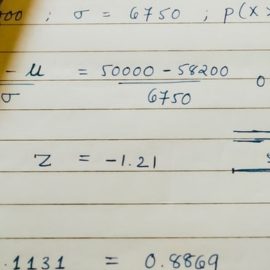

This article is an excerpt from the Shortform book guide to "The Art of Thinking Clearly" by Rolf Dobelli. Shortform has the world's best summaries and analyses of books you should be reading.
Like this article? Sign up for a free trial here .
What is exponential growth? What are some real-world examples of exponential growth?
Exponential growth is a complex math concept that many people don’t instinctively understand. Yet, the idea is pretty simple: Exponential growth simply means that a number doubles at regular intervals.
Let’s take a closer look at the meaning of exponential growth and a few examples.
Exponential Growth
Most things in nature increase linearly, where a number increases by the same amount at regular intervals. For example, if you add one rock to a pile every day, on the 15th day, you’ll have 15 rocks. This is a basic concept that early humans encountered, so your brain naturally understands this kind of growth.
However, the meaning of exponential growth is that the number doubles at regular intervals, Dobelli explains. For example, you add one rock to a pile on day one, two rocks the next day, four rocks the next day, and so on. By day 15, you’ll have 16,384 rocks. This is not a concept that early humans encountered, so your brain struggles to grasp it. However, it’s increasingly common in the modern world and thus crucial to understand: Everything from investments to product sales can grow exponentially.
Exponential Growth in Nature and Modern Life
While Dobelli is correct that exponential growth was rarely observed by early humans and is now much more observable in modern fields such as finance, exponential growth is still possible in the natural world that early humans would have experienced. For example, if two dogs have six puppies, and each puppy also has six puppies, the dog population would experience exponential growth. However, natural exponential growth is limited by resources: The dog population can only grow exponentially until it reaches “carrying capacity,” the maximum number of dogs the environment can support. Thus, while natural exponential growth is possible, it’s rare.
Furthermore, early humans may not have identified natural exponential growth because it’s only noticeable if you keep track of all members of a species, which wasn’t possible millions of years ago. However, it’s easier with modern technology. Once you’re tracking the species, you can spot exponential growth by finding the “doubling time”: If the population of a species doubles within a week, for example, see if it doubles again next week. If the population continues to double within the same time (or faster), it’s experiencing exponential growth.

———End of Preview———
Like what you just read? Read the rest of the world's best book summary and analysis of Rolf Dobelli's "The Art of Thinking Clearly" at Shortform .
Here's what you'll find in our full The Art of Thinking Clearly summary :
- A detailed look at the most common logical fallacies that inhibit decision-making
- How to recognize and overcome these fallacies to make better decisions
- Why you value things for arbitrary reasons






